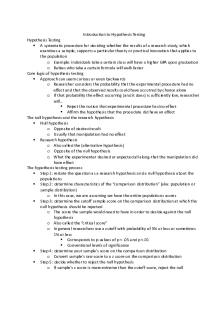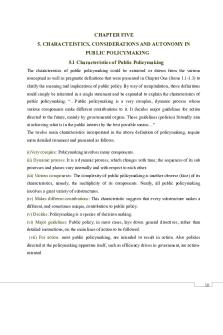Lecture Five - Linda Meegan PDF

| Title | Lecture Five - Linda Meegan |
|---|---|
| Author | Namrata Roy |
| Course | Business Communications 2 |
| Institution | British Columbia Institute of Technology |
| Pages | 3 |
| File Size | 91.4 KB |
| File Type | |
| Total Downloads | 61 |
| Total Views | 131 |
Summary
Linda Meegan...
Description
Lecture Five AMFEM: Attention-getter–separate opening paragraph Main idea, Features & Benefits –main idea followed by features and benefits, in short, logically/strategically sequenced paragraphs Evidence–either following all features and benefits, or integrated with them, in short , logically/strategically sequenced paragraph Motivator & Action–separate closing paragraph Two kinds of persuasive messages: 1. Request for information 2. Request for purchase of product/service Request for Info/Action: Gaining Attention Compliment Unexpected fact Thought-provoking question Reader benefit Summary of problem Request for help Presenting Main Idea, Features & Benefits to build interest State main idea and attractively describe its features (at least three) Describe direct and indirect, rational and emotional benefits (at least three) for the receiver Either present evidence after all features and benefits, or integrate evidence with each feature and benefit Providing Evidence to Reduce Resistance Offer at lease three pieces of evidence to support claims about features and benefits Evidence should: Overcome possible objections Be objective (3rd party, outside of you) Be specific (names, numbers, dates, measurements) Kinds of evidence are: Facts, figures, logic, stories, examples Motivating Action Ask for specific next-step action confidently Give a method; make it easy Include an end date if appropriate Offer motivator (repetition of key benefit)
Subject Lines in Persuasive Messages Indirect persuasive-messages subject lines draw the reader in without revealing the main idea They are either neutral or an advance attention-getting device o e-mails: need a subject line o Letters: don’t need subject line Sentences = max. 20 words Paragraphs = max. 8 lines See examples in lecture for before/after messages
Request for Purchase of Product/Service: Gaining Attention Free offer of something attractive/valuable Promise of a significant result Question that's likely on the reader's mind Quotation (recent, relevant, intriguing) Product/service feature (most attractive) Testimonial (positive) Startling statement (relevant, intriguing) Presenting Main Idea, Features & Benefits to build interest Product/service description (features) Reader benefits o What each feature does for the reader: how it saves money/makes money, improves health, boosts status, reduces effort, produces pleasure, etc. Rational appeals - facts, figures, logic Emotional appeals - stories, people, feelings Providing Evidence to Reduce Resistance Testimonials Description of satisfied users Guarantee Attractive warranty Free trial Free sample Results of performance tests Results of polls Reviews, ratings Awards received Motivating Action Close by repeating the central selling point and clear instructions for an easy next-step action to be taken o Gift o Incentive o Limited offer
o o o
Deadline Guarantee Repetition of selling features
Refer to lecture slides for examples of before/after messages...
Similar Free PDFs

Lecture Five - Linda Meegan
- 3 Pages

Linda nochlin
- 7 Pages

PROPOSAL LINDA
- 3 Pages

Linda Assignments Done
- 12 Pages

Five - Apuntes Five
- 6 Pages

Mod Five - Mod Five
- 2 Pages

SBAR linda waterfall VSIM
- 2 Pages

Linda Waterfall GRQ - sim
- 2 Pages

Para mi gordita linda lina
- 1 Pages
Popular Institutions
- Tinajero National High School - Annex
- Politeknik Caltex Riau
- Yokohama City University
- SGT University
- University of Al-Qadisiyah
- Divine Word College of Vigan
- Techniek College Rotterdam
- Universidade de Santiago
- Universiti Teknologi MARA Cawangan Johor Kampus Pasir Gudang
- Poltekkes Kemenkes Yogyakarta
- Baguio City National High School
- Colegio san marcos
- preparatoria uno
- Centro de Bachillerato Tecnológico Industrial y de Servicios No. 107
- Dalian Maritime University
- Quang Trung Secondary School
- Colegio Tecnológico en Informática
- Corporación Regional de Educación Superior
- Grupo CEDVA
- Dar Al Uloom University
- Centro de Estudios Preuniversitarios de la Universidad Nacional de Ingeniería
- 上智大学
- Aakash International School, Nuna Majara
- San Felipe Neri Catholic School
- Kang Chiao International School - New Taipei City
- Misamis Occidental National High School
- Institución Educativa Escuela Normal Juan Ladrilleros
- Kolehiyo ng Pantukan
- Batanes State College
- Instituto Continental
- Sekolah Menengah Kejuruan Kesehatan Kaltara (Tarakan)
- Colegio de La Inmaculada Concepcion - Cebu






